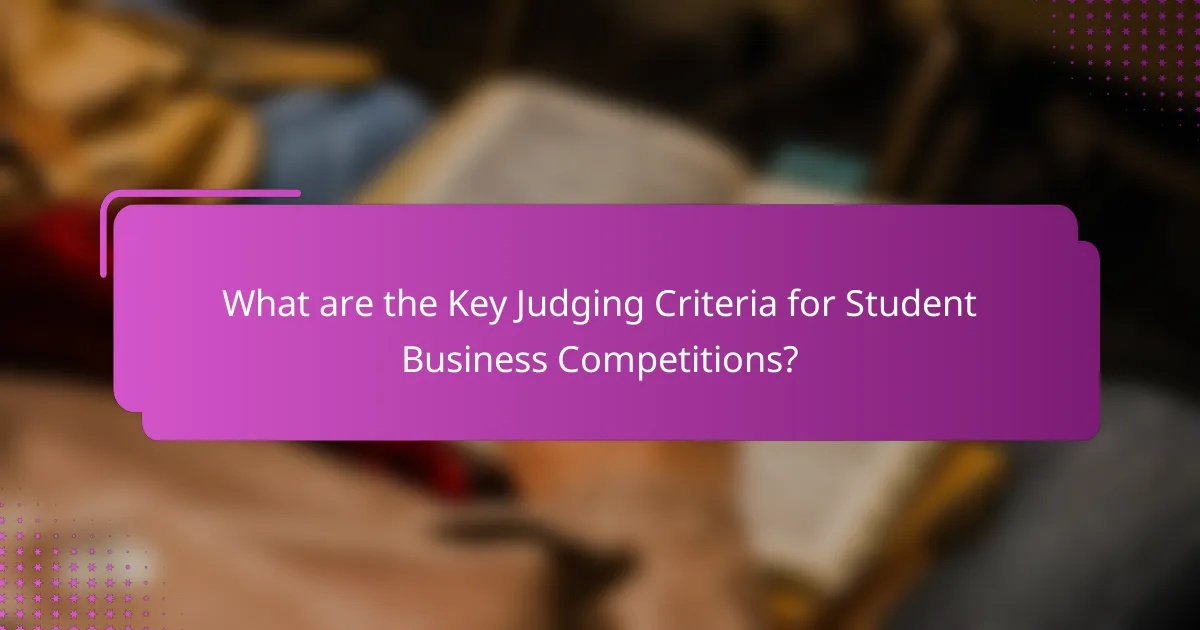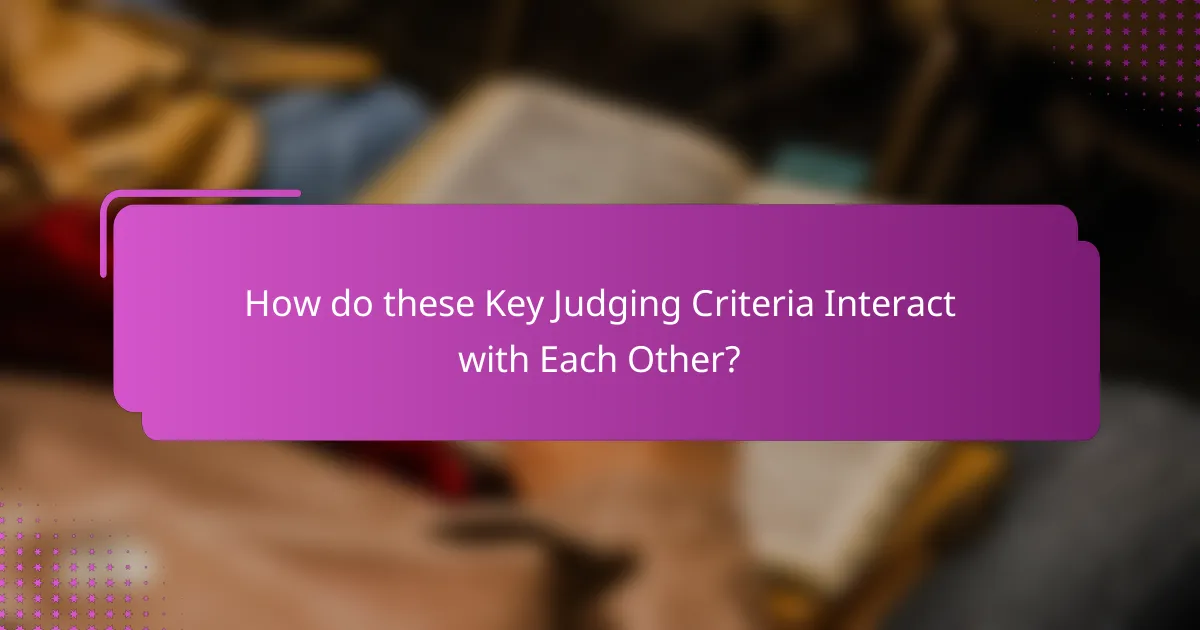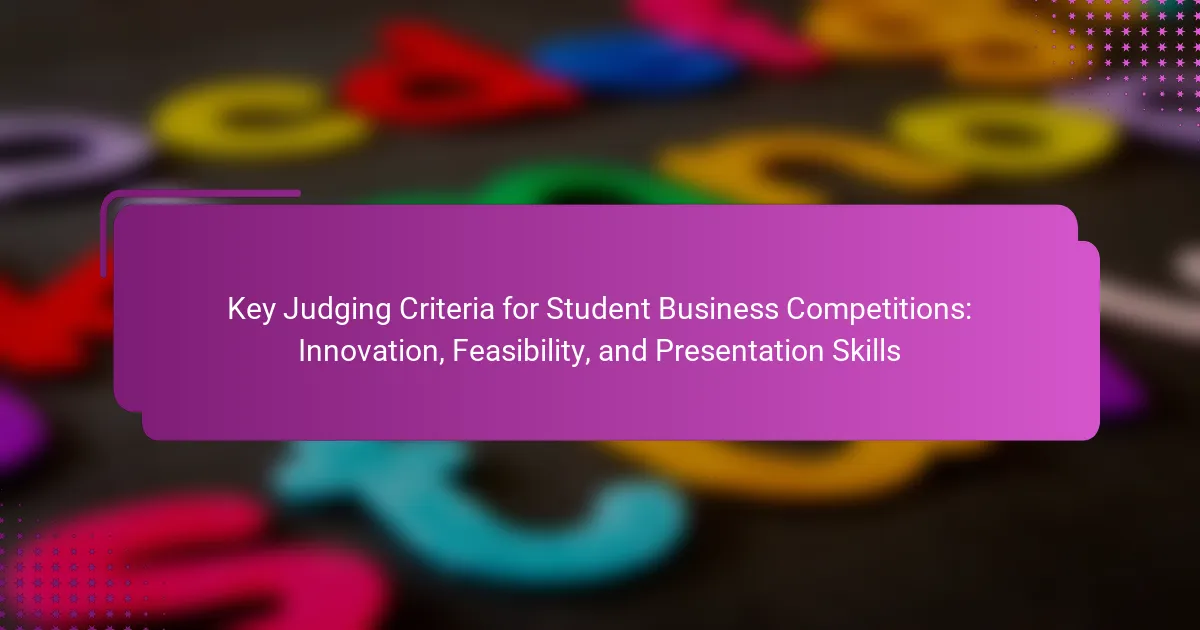The article focuses on the key judging criteria for student business competitions, specifically highlighting innovation, feasibility, and presentation skills. Innovation evaluates the originality and creativity of business ideas, while feasibility assesses the practicality of these concepts. Presentation skills measure the effectiveness of communication during pitches, including clarity and engagement. The interrelationship among these criteria is crucial, as a strong innovative idea must also be feasible and effectively presented to resonate with judges. Participants are encouraged to prepare thoroughly, practice their presentations, and utilize visual aids to enhance their pitches, ensuring a comprehensive and compelling delivery.

What are the Key Judging Criteria for Student Business Competitions?
The key judging criteria for student business competitions include innovation, feasibility, and presentation skills. Innovation assesses the originality and creativity of the business idea. Feasibility evaluates the practicality and viability of the proposed business model. Presentation skills measure the effectiveness of communication and engagement during the pitch. Judges often look for clarity, confidence, and the ability to answer questions. A well-rounded evaluation incorporates these dimensions to determine the overall potential of the business concept.
Why is Innovation a Crucial Judging Criterion?
Innovation is a crucial judging criterion because it reflects the ability to develop unique solutions. Unique solutions can differentiate a business in a competitive market. They often lead to improved efficiency and effectiveness. According to a report by McKinsey, companies that prioritize innovation see a 10% higher growth rate. This demonstrates that innovation is linked to economic performance. Furthermore, innovative ideas can attract investors and customers. They signal adaptability and forward-thinking. Thus, innovation is essential for long-term success in business competitions.
What specific aspects of Innovation are judges looking for?
Judges are looking for originality, practicality, and impact in innovation. Originality refers to the uniqueness of the idea. Judges assess how different the concept is from existing solutions. Practicality evaluates the feasibility of implementing the innovation. Judges consider whether the idea can be realistically executed within a certain timeframe and budget. Impact measures the potential benefits of the innovation. Judges look for how the idea addresses specific problems or improves existing processes. These aspects help judges determine the overall strength of the innovation presented.
How can participants demonstrate Innovation effectively?
Participants can demonstrate innovation effectively by presenting unique solutions to existing problems. They should identify gaps in the market and propose creative ideas that address these gaps. Utilizing research to support their concepts is essential. Participants can also showcase prototypes or models to illustrate their ideas. Engaging storytelling can enhance the presentation of their innovative concepts. Collaborating with diverse teams can lead to more inventive solutions. Feedback from peers can refine their ideas further. These strategies collectively enhance the perception of innovation in their projects.
How does Feasibility Impact Judging in Business Competitions?
Feasibility significantly impacts judging in business competitions by determining the practicality of proposed ideas. Judges evaluate whether a business concept can be realistically implemented. This assessment includes analyzing market demand, resource availability, and financial viability. A feasible plan demonstrates a clear path to execution, which is crucial for success. Judges often prioritize feasible ideas over innovative but impractical ones. According to research by the Kauffman Foundation, feasibility assessments can influence up to 40% of scoring in competitions. Thus, feasibility is a critical criterion that shapes the overall judgment process.
What factors contribute to the Feasibility of a business idea?
The feasibility of a business idea is influenced by several key factors. These include market demand, financial viability, and operational requirements. Market demand assesses whether there is a customer base willing to purchase the product or service. Financial viability examines if the business can generate sufficient revenue to cover costs. Operational requirements involve evaluating the resources, technology, and skills needed to implement the business idea effectively. Additionally, competition analysis provides insight into the market landscape and potential challenges. Legal and regulatory considerations ensure that the business complies with relevant laws. Finally, scalability assesses whether the business can grow and adapt over time. Each factor plays a critical role in determining the overall feasibility of a business idea.
How can competitors assess the Feasibility of their proposals?
Competitors can assess the feasibility of their proposals by conducting thorough market research. This involves analyzing target demographics and understanding market needs. Competitors should evaluate the financial viability of their proposals, including cost analysis and potential revenue. They must also consider the technical requirements and resources needed for implementation. Assessing the competitive landscape is crucial; this includes identifying existing competitors and their offerings. Additionally, gathering feedback from potential customers can provide insights into the proposal’s practicality. Utilizing feasibility analysis tools can further enhance this assessment. These methods collectively ensure that the proposal is realistic and achievable within the given constraints.
What Role do Presentation Skills Play in Judging?
Presentation skills are critical in judging as they directly influence the perception of a competitor’s idea. Effective presentation skills enhance clarity and engagement. Judges assess how well competitors communicate their concepts. Strong delivery can elevate a mediocre idea to a more favorable evaluation. Research shows that clear communication impacts decision-making processes. In student business competitions, the ability to convey information succinctly is vital. Judges often favor presentations that are well-structured and visually appealing. Thus, presentation skills significantly affect scoring and overall outcomes in competitions.
What elements make a Presentation impactful in competitions?
An impactful presentation in competitions includes clarity, engagement, and visual appeal. Clarity ensures that the message is easily understood. Engaging the audience maintains their interest and attention. Visual appeal enhances retention of information. Effective storytelling can make complex ideas relatable. Practice improves delivery and confidence. Time management ensures all key points are covered succinctly. Feedback from peers can refine the presentation. These elements collectively contribute to a memorable and persuasive presentation.
How can participants improve their Presentation Skills for better outcomes?
Participants can improve their presentation skills by practicing regularly. Engaging in mock presentations helps build confidence. Utilizing feedback from peers enables refinement of delivery. Understanding the audience enhances message relevance. Incorporating visual aids can clarify complex points. Mastering body language improves engagement. Structuring content logically aids comprehension. Research indicates that practice can increase retention and performance by up to 20%.

How do these Key Judging Criteria Interact with Each Other?
The key judging criteria of innovation, feasibility, and presentation skills interact through a synergistic relationship. Innovation drives creativity and sets the foundation for unique business ideas. Feasibility assesses whether these innovative ideas can be realistically implemented. Presentation skills communicate both the innovative aspects and the feasibility to judges effectively.
A strong innovative concept can be undermined if it lacks feasibility. Conversely, a feasible idea may not stand out if it lacks innovation. Good presentation skills enhance both criteria, making the overall pitch more compelling. Judges often look for a balance among these criteria to determine the potential success of a business idea. Each criterion influences the others, creating a comprehensive evaluation framework for student business competitions.
Why is it important to balance Innovation, Feasibility, and Presentation Skills?
Balancing Innovation, Feasibility, and Presentation Skills is crucial for success in business competitions. Innovation drives creative solutions that can differentiate ideas. Feasibility ensures that these ideas can be realistically implemented and sustained. Presentation Skills are vital for effectively communicating these ideas to judges and stakeholders. Without innovation, projects may lack uniqueness and relevance. Without feasibility, even the best ideas may fail in execution. Without strong presentation skills, innovative and feasible ideas may not be understood or appreciated. A study by Harvard Business Review highlights that well-presented ideas significantly increase buy-in from audiences. Balancing these three elements maximizes the potential for success in competitions.
How can participants integrate these criteria into their projects?
Participants can integrate the criteria of innovation, feasibility, and presentation skills into their projects by systematically addressing each aspect. First, they should ensure their project introduces a novel solution or approach, demonstrating creativity and originality. This can be achieved through brainstorming sessions and market research to identify gaps.
Next, participants must evaluate the feasibility of their ideas. They should conduct a thorough analysis of resources, time, and potential challenges involved in implementation. This involves creating a realistic plan that outlines steps to bring the idea to fruition.
Finally, participants need to hone their presentation skills. They should practice delivering clear and engaging presentations that effectively communicate their project’s value. Utilizing visual aids and storytelling techniques can enhance the audience’s understanding and interest.
By focusing on these three criteria, participants can create a well-rounded project that meets the expectations of judges in competitions.

What Best Practices Should Participants Follow to Excel in Competitions?
Participants should focus on preparation, practice, and presentation skills to excel in competitions. Thorough research on the competition topic enhances understanding and innovation. Participants must develop a clear and feasible business plan. Regular practice of presentations helps build confidence and clarity. Engaging storytelling captures the judges’ attention effectively. Visual aids should be used to support key points and enhance understanding. Feedback from peers can provide valuable insights for improvement. Lastly, time management during the presentation ensures all critical aspects are covered within the allotted time.
What strategies can enhance the Innovation aspect of a business proposal?
Incorporating diverse perspectives can enhance the innovation aspect of a business proposal. Engaging a multidisciplinary team fosters creativity. This team should include members from various fields. Their unique insights lead to innovative solutions. Conducting market research is another effective strategy. This research identifies gaps and emerging trends. Addressing these gaps can spark new ideas. Utilizing technology also boosts innovation. Implementing the latest tools streamlines processes and enhances creativity. Encouraging an experimental culture promotes risk-taking. This culture allows for testing and refining ideas. Lastly, soliciting feedback from stakeholders can refine concepts. Their input helps align innovations with market needs.
How can research and development contribute to stronger Innovation?
Research and development (R&D) significantly enhances innovation by facilitating the discovery of new ideas and technologies. R&D enables organizations to explore and experiment with novel concepts. This process leads to improved products and services that meet evolving consumer needs. Furthermore, R&D fosters a culture of creativity and problem-solving within teams.
According to the National Science Foundation, companies that invest in R&D are more likely to introduce innovative products. In fact, businesses that prioritize R&D can achieve up to 20% higher revenue growth compared to their competitors. This demonstrates the critical role of R&D in driving innovation and maintaining competitive advantage.
What practical steps can ensure the Feasibility of a business idea?
Conduct thorough market research to understand demand. Identify target customers and their needs. Analyze competitors to assess market saturation. Develop a clear business plan outlining goals and strategies. Create a financial model to project costs and revenues. Validate the idea through prototypes or pilot programs. Seek feedback from potential customers to refine the concept. Assess legal and regulatory requirements for compliance.
How can market analysis support the Feasibility assessment?
Market analysis supports feasibility assessment by providing essential data on market demand and competition. It identifies potential customer segments and their needs. This information helps assess whether a business idea can attract sufficient customers. Market analysis also evaluates the competitive landscape. Understanding competitors’ strengths and weaknesses aids in determining market entry strategies. Additionally, it forecasts potential revenue and profitability. Accurate market data can indicate whether the financial projections are realistic. Thus, market analysis is crucial in validating the feasibility of a business concept.
What tips can improve Presentation Skills for competitions?
Practice regularly to enhance presentation skills for competitions. Rehearsing builds confidence and familiarity with the content. Use clear and concise language to communicate ideas effectively. Visual aids should be relevant and enhance understanding. Maintain eye contact to engage the audience and convey confidence. Control your pace and tone to emphasize key points. Solicit feedback from peers to identify areas for improvement. Familiarize yourself with the competition format and judging criteria to tailor your presentation accordingly.
How can visual aids enhance the effectiveness of a presentation?
Visual aids enhance the effectiveness of a presentation by improving audience engagement and retention of information. They help clarify complex concepts through visual representation. Research shows that people remember 80% of what they see and do compared to only 20% of what they read. Visual aids can simplify data, making it easier for the audience to grasp key points. They also maintain the audience’s attention, reducing cognitive overload. Studies indicate that presentations with visual aids are 43% more persuasive than those without. This increased clarity and engagement can significantly impact the overall effectiveness of a presentation.
The main entity of the article is the key judging criteria for student business competitions, specifically focusing on innovation, feasibility, and presentation skills. The article outlines how innovation reflects originality and creativity, feasibility assesses the practicality of business ideas, and presentation skills impact judges’ perceptions. It details the specific aspects judges evaluate within each criterion and provides strategies for participants to effectively demonstrate these elements in their projects. Additionally, the article emphasizes the importance of balancing these criteria to enhance the potential for success in competitions.
